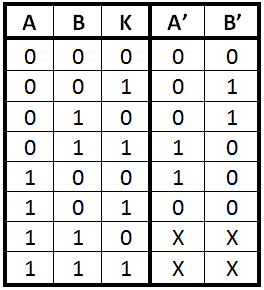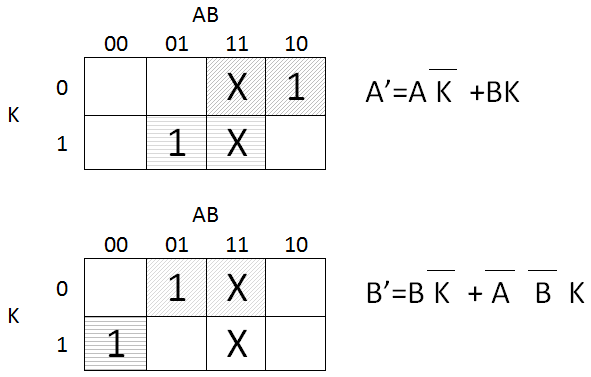Finding a Number which Appears Once in Array where All Other Numbers Appear Three Times
by Zoran Horvat
Problem Statement
An array of integers is given, such that each number appears exactly three times in it with exception of one number which appears only once. Write a function returning number which appears once in the array.
Example: Suppose that array consists of numbers 2, 4, 5, 1, 1, 4, 1, 2, 3, 5, 5, 4, 2. The function should return value 3, because that is the number which appears only once. All other numbers appear three times.
For similar problem, please refer to exercise Finding a Number That Appears Once in Array of Duplicated Numbers .
Another variation of the problem is covered in exercise Finding Two Numbers That Appear Once in Array of Duplicated Numbers .
Problem Analysis
This problem resembles a similar problem where all numbers appear exactly twice, except one which appears once. Solution to this problem is explained in exercise Finding a Number That Appears Once in Array of Duplicated Numbers . Although solution is not directly applicable to problem were numbers appear three times each, we can still make use of it.
Suppose that we can isolate one particular bit in each of the numbers in the array. Now we can add values of that bit in all numbers and see whether the result is divisible by 3 or not. This test tells us about the number which appears once, because all other numbers either contribute with value 3 or with value 0. If sum is divisible with 3, then this bit in the number which appears once must be 0; otherwise it must be 1.
We can now proceed towards solving the problem by making modulo 3 sums for each of the bits in numbers in the array. But since summation modulo 3 has greatest value 2, it is obvious that intermediate results cannot be stored in one bit each. One efficient way is to keep intermediate sums in a pair of bits for each bit in the number. Alternative, we could use two integer numbers A and B, such that bits in B represent low-order bits of the modulo 3 sum, while bits in A represent high-order bits of the modulo 3 sum.
The operation then proceeds by analyzing what bitwise operations should be applied so that digits in base 3 represented by bits of A and B really resemble modulo 3 addition results. Suppose that A and B are just one bit long. In that case, when digit K (0 or 1) is added to two-bit number AB, the result of modulo 3 addition operation is given in the following table:

Values X in the output indicates values that are not important because inputs can never be reached in normal operation – namely, intermediate result can never be 11 (binary), which is 3 decimal because we are performing modulo 3 addition. To extract closed form functions for new A and B, we will use Karnaugh maps .

These expressions will give us the way to combine bits from all numbers in the array. Finally, each bit in the result which corresponds to AB=00 will be zero, otherwise 1. So, resulting number is just A OR B. Below is the pseudocode which implements this algorithm. Note that all Boolean operations in the code are bitwise operations.
function FindUniqueNumber(v, n)
-- v – array of integers
-- n – number of elements in a
begin
a = b = 0
for i = 1, n
begin
a’ = (a AND NOT v[i]) OR (b AND v[i])
b = (b AND NOT v[i]) OR (NOT a AND NOT b AND v[i])
a = a’
end
return a OR b
end
Quite an astonishing piece of code when you know how complicated it is to find which number appears exactly once.
Implementation
Below is the C# console application which lets the user enter array of integers and then prints the number which appears once in the array.
using System;
class Program
{
static int FindUniqueNumber(int[] array)
{
int a = 0;
int b = 0;
for (int i = 0; i < array.Length; i++)
{
int a1 = (a & ~array[i]) | (b & array[i]);
b = (b & ~array[i]) | (~a & ~b & array[i]);
a = a1;
}
return a | b;
}
static void Main()
{
while (true)
{
int[] a = ReadArray();
if (a.Length == 0)
break;
int unique = FindUniqueNumber(a);
Console.WriteLine("Number appearing once is {0}.", unique);
Console.WriteLine();
}
}
static int[] ReadArray()
{
Console.WriteLine("Enter array (ENTER to quit):");
string line = Console.ReadLine();
string[] parts = line.Split(new char[] { ' ' },
StringSplitOptions.RemoveEmptyEntries);
int[] a = new int[parts.Length];
for (int i = 0; i < a.Length; i++)
a[i] = int.Parse(parts[i]);
return a;
}
}
Demonstration
When application above is run, it produces output like this:
Enter array (ENTER to quit):
2 4 5 1 1 4 1 2 3 5 5 4 2
Number appearing once is 3.
Enter array (ENTER to quit):
3 8 5 6 2 8 6 4 7 9 7 6 5 9 1 5 9 4 3 3 1 1 7 8 4
Number appearing once is 2.
Enter array (ENTER to quit):
If you wish to learn more, please watch my latest video courses

Beginning Object-oriented Programming with C#
In this course, you will learn the basic principles of object-oriented programming, and then learn how to apply those principles to construct an operational and correct code using the C# programming language and .NET.
As the course progresses, you will learn such programming concepts as objects, method resolution, polymorphism, object composition, class inheritance, object substitution, etc., but also the basic principles of object-oriented design and even project management, such as abstraction, dependency injection, open-closed principle, tell don't ask principle, the principles of agile software development and many more.
More...

Design Patterns in C# Made Simple
In this course, you will learn how design patterns can be applied to make code better: flexible, short, readable.
You will learn how to decide when and which pattern to apply by formally analyzing the need to flex around specific axis.
More...

Refactoring to Design Patterns
This course begins with examination of a realistic application, which is poorly factored and doesn't incorporate design patterns. It is nearly impossible to maintain and develop this application further, due to its poor structure and design.
As demonstration after demonstration will unfold, we will refactor this entire application, fitting many design patterns into place almost without effort. By the end of the course, you will know how code refactoring and design patterns can operate together, and help each other create great design.
More...

Mastering Iterative Object-oriented Development in C#
In four and a half hours of this course, you will learn how to control design of classes, design of complex algorithms, and how to recognize and implement data structures.
After completing this course, you will know how to develop a large and complex domain model, which you will be able to maintain and extend further. And, not to forget, the model you develop in this way will be correct and free of bugs.
More...
About

Zoran Horvat is the Principal Consultant at Coding Helmet, speaker and author of 100+ articles, and independent trainer on .NET technology stack. He can often be found speaking at conferences and user groups, promoting object-oriented and functional development style and clean coding practices and techniques that improve longevity of complex business applications.
Elsewhere
Video Courses
- Making Your C# Code More Object-oriented
- Beginning Object-oriented Programming with C#
- Collections and Generics in C#
- Design Patterns in C# Made Simple
- Refactoring to Design Patterns
- Mastering Iterative Object-oriented Programming in C#
- Making Your C# Code More Functional
- Making Your Java Code More Object-oriented
- Writing Purely Functional Code in C#
- Tactical Design Patterns in .NET: Creating Objects
- Tactical Design Patterns in .NET: Control Flow
- Tactical Design Patterns in .NET: Managing Responsibilities
- Advanced Defensive Programming Techniques
- Writing Highly Maintainable Unit Tests
- Improving Testability Through Design
Articles
- Here is Why Calling a Virtual Function from the Constructor is a Bad Idea
- What Makes List<T> So Efficient in .NET?
- Nondestructive Mutation and Records in C#
- Understanding Covariance and Contravariance of Generic Types in C#
- Using Record Types in C#
- Unit Testing Case Study: Calculating Median
- More...